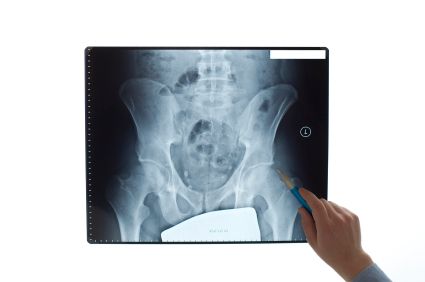Article
DOACs Tied to Lower Osteoporotic Fracture Risk than Warfarin
Author(s):
A new analysis suggests DOAC use was associated with a lower risk of osteoporotic fracture than warfarin.
A physician examines an x-ray of a patient's hip fracture.

Results of a new analysis are revealing more about the potential reduction in osteoporotic fracture seen with use of direct oral anticoagulants (DOACs) versus warfarin in patients with atrial fibrillation.
Results of the analysis, which examined use in a cohort of more than 20k patients, found use of DOACs, such as apixaban, dabigatran, and rivaroxaban, was associated with a reduced risk of osteoporotic hip and vertebral fractures in patients with atrial fibrillation.
While the vitamin K antagonist warfarin had carved its respective role in the management of various cardiovascular indications, DOAC use is becoming more and more popular—so much so that DOACs have begun receiving recommendations over warfarin for certain conditions, such as reducing stroke risk in patients with atrial fibrillation. With this in mind, an international team of investigators sought to determine whether anticoagulant type was associated with risk for osteoporotic fracture in a population-based cohort study.
Using electronic medical record data of 23,515 patients, investigators hoped to compare the rates of osteoporotic hip and vertebral fractures in anticoagulant users using propensity score-weight cumulative differences (CID). Of note, all patients included in the study were identified using data from the territory-wide electronic health record database of the Hong Kong Hospital Authority.
The primary outcome of interest in the analysis was defined as a composite of hip and vertebral fractures, which investigators identified through the use of ICD-9 codes. Investigators pointed out fractures recorded with a traumatic event were censored to reduce confounding. Additionally, patients were followed until the primary outcome occurred, treatment was discontinued, patients switched from index medication to another DOAC, or the end of the study period.
All patients included in the study were 18 years of age or older, had newly diagnosed atrial fibrillation, and receiving bed a new prescription for 1 of the DOACs of interest. Newly diagnosed atrial fibrillation was defined as a first diagnosis from 2010-2017.
Of the 23,515 patients with newly diagnosed atrial fibrillation who met the criteria for a new anticoagulant user, 3241 were using apixaban, 6867 were using dabigatran, 3866 were using rivaroxaban, and 9541 were using warfarin. The study cohort had a mean age of 74.4 years and a median follow-up of 423 days.
During the follow-up period, 401 fractures occurred among the study cohort. Crude events numbers were 53 (0.82 per 100 patient-years) with apixaban, 95 (0.76 per 100 patient-years), 57 (0.67 per 100 patient-years), and 196 (1.11 per 100 patients-years) with warfarin. After 24 months, results of the analysis indicated DOAC use was associated with a lower risk of fracture than warfarin use.
Analyses yielded specific CIDs of -0.88% (95% CI, -1.66% to -0.21%) for apixaban, -0.81% (95% CI, -1.34% to -0.23%) for dabigatran, and -1.13% (95% CI, -1.67% to -0.53%) for rivaroxaban. When comparing the DOACs in head-to-head comparisons, no differences were observed between agents at 24 months.
“This study found that among patients with AF, use of DOACs was associated with a lower risk for osteoporotic fracture than use of warfarin. No evidence of a differential fracture risk between DOACs was found,” said study investigators.
This study, “Association Between Treatment With Apixaban, Dabigatran, Rivaroxaban, or Warfarin and Risk for Osteoporotic Fractures Among Patients With Atrial Fibrillation,” was published in the Annals of Internal Medicine.





